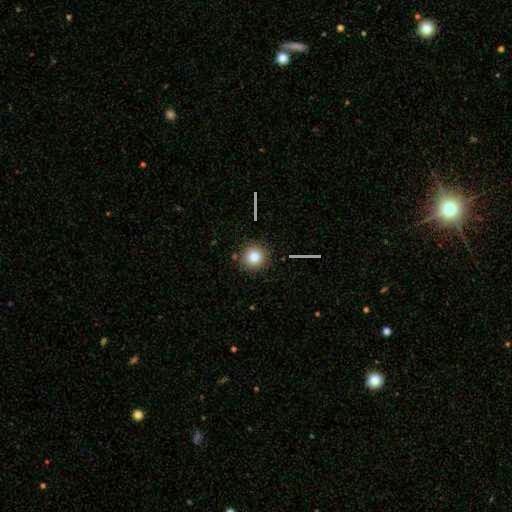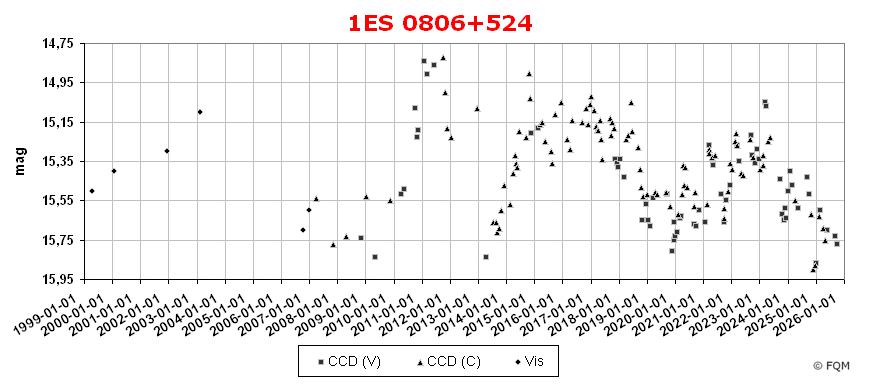
| Frankfurt Quasar Monitoring |
| 1ES 0806+524 |
| Cross-Identifications | RGB J0809+523, QSO B0806+524, 1E 0806+524 SDSS J080949.18+521858.2, 3EG J0809+5218 RX J0809.8+5218, 1RXS J080949.2+521855 1ES 0806+52.4, FIRST J080949.1+521858 87GB 080601.8+522753, GB6 J0809+5218 |
| Equat. coordinates | RA 08 09 49.2 DE +52 18 58 (J2000) |
| Constellation | Lynx |
| Type | BL Lac |
| Redshift | z=0.138 |
| Distance (2) (3) |
552 Mpc |
| Total mag range (mv) (4) (5) | 14.8 - 16.3 |
| Catalog Magnitude (1) | 15.3 |
| Absolute Magnitude (1) | -24.3 MB |
| Light Travel-Time (2) | 1.687 × 109 yrs |

Comparison stars
| star | V | Rc | Ic |
| C1 | 13.04
(0.05) |
12.56
(0.05) |
12.14
(0.05) |
| C2 | 14.61
(0.05) |
14.22 (0.04) | 13.86 (0.04) |
| C3 | 14.77
(0.05) |
14.39
(0.05) |
14.04
(0.05) |
| C4 | 15.49
(0.06) |
15.14
(0.06) |
14.81
(0.06) |
| C5 | 15.62
(0.06) |
15.32
(0.05) |
14.99 (0.06) |

 Credit: SDSS /
Size 3´× 3´
galaxy of 1ES 0806+524 as a bright starlike nucleus surrounded by a diffuse extended circular halo (app. diam. 0.23´× 0.21´) |
 Credit: Scarpa et
al. (1999) / Size 18.6"×18.6"
This
image from Hubble Space Telescopeshows the well-resolved host galaxy. (The arclike structure 1.9" south of the bright nucleus possibly is a bright elliptical shell or the remnant of a previous gravitational interaction) |

| 1ES
0806+524 is a variable BL Lac object in north-eastern Lynx,
close to the star 27 Lyn. The
designation 1ES 0806+524 refers to the Einstein
Slew Survey, where this object was cataloged as an X-ray source
in the early 1990s. Initially, 1ES
0806+524 was discovered as a radio source in 1987 with
the 91-m Green Bank radio telescope. Radio
interferometry revealed a short northbound
jet. The host galaxy of 1ES
0806+524 was
identified as an elliptical galaxy with an apparent diameter of 0.23´×
0.21´. A remarkable arc-like
structure, about 2" south of the nucleus, was found by the Hubble Space
Telescope, which might be a bright elliptical shell or the
remnant of a previous gravitational interaction. The
first redshift of z=0.138
was measured in the late 1990s, based on weak absorption lines. Earlier
attempts revealed only a featureless spectrum. Besides the radio and
X-ray, 1ES
0806+524 was also identified as a gamma source by EGRET
on board of Compton Gamma Ray Observatory in 1999/2000. ____________
1ES
0806+524 is located in north-eastern Lynx, only 50´N of the 4.8-mag
star 27 Lyn. A nice observing object lies 7.5° NW, well
suited for small telescopes.
That is double star 19 Lyn (=STF1062), consisting of a 5.6-mag primary
and a 6.5-mag
companion (both type B stars), separated by 14.8". Three nearby galaxies might also attract the observers interest. First turn the telescope 6.8° E to meet NGC 2681, a bright 11.1-mag face-on SB0a spiral, with a very bright stellar nucleus. Some 4° further to the east (11.3° E of 0806+524) there is NGC 2841, a large and bright 10.1-mag lense-shaped spiral. A very special object is NGC 2685, 9.2° NE in UMa, also dubbed the Helix- or Pancake-Galaxy. NGC 2685 is a 12.1-mag Polar-Ring Galaxy, the result of an ongoing galaxy merger (Arp 336), the brightest of its class. Another bright extragalactic variable is waiting for the dedicated observer. S5 0716+71 is a violently variable BL Lac object, located 19.7° N at a distance of about 3×109 light-years. And finally, sweep the telescope 18.8° to the SSE to find another bright quasar. PG 0844+349 is a bright 13-mag to 14-mag object at a distance of about 0.8×109 light-years. |
| Bade, N., Fink, H.H., Engels, D. 1994, A&A, 286, 381; New X-ray bright BL Lacertae objects from the ROSAT All-Sky Survey. Becker, R.H., White, R.L., Edwards, A.L. 1991, ApJS, 75, 1B; A new catalog of 53,522 4.85 GHz sources. Costamante, L., Ghisellini, G. 2002, A&A, 384, 56; TeV candidate BL Lac objects. Fiorucci, M., Tosti, G., Rizzi, N. 1998, PASP, 110, 105; VRI Photometry of Stars in the fields of 16 Blazars. Gioia, I.M., Maccacaro, T. 1990, ApJS, 72, 567; The Einstein Observatory Extended Medium-Sensitivity Survey. I - X-ray data and analysis. Perlman, E.S., Stocke, J.T., et al. 1996, ApJS, 104, 251; The Einstein Slew Survey Sample of BL Lacertae Objects. Rector, T.A., Gabuzda, D.C., Stocke, J.T. 2003, AJ, 125, 1060; The Radio Structure of High-Energy-Peaked BL Lacertae Objects. Scarpa, R., Urry, C.M., et al. 1999, ApJ, 521, 134: Hubble Space Telescope Survey of BL Lacertae Objects: Gravitational lens Candidates and other unusual sources. Schachter, J.F., Stocke, J.T., et al. 1993, ApJ, 412, 541; Ten new BL Lacertae objects discovered by an efficient X-ray/radio/optical technique. Véron-Cetty, M.-P., Véron, P. 2001, A&A 374, 92; A Catalogue of Quasars and Active Nuclei: 10th edition. Véron-Cetty, M.-P., Véron, P. 2003, A&A 412, 399; A Catalogue of Quasars and Active Nuclei: 11th edition. Véron-Cetty, M.-P., Véron, P. 2006, A&A 455, 776; A Catalogue of Quasars and Active Nuclei: 12th edition. Véron-Cetty, M.-P., Véron, P. 2010, A&A 518, 10; A Catalogue of Quasars and Active Nuclei: 13th edition. |
| Links: Landessternwarte Heidelberg Sloan Digital Sky Survey |